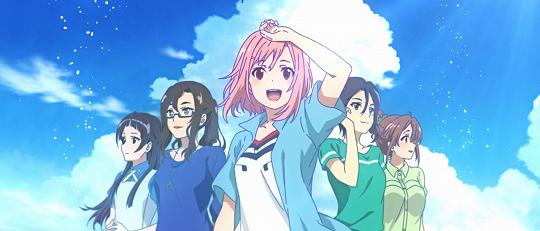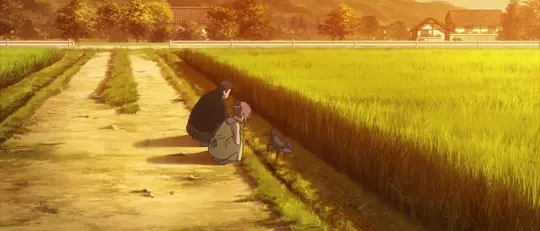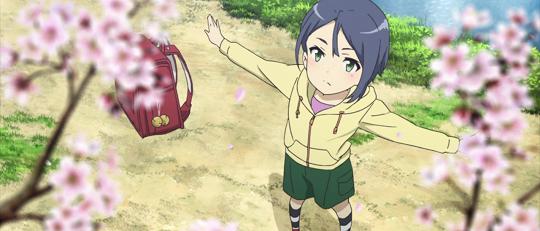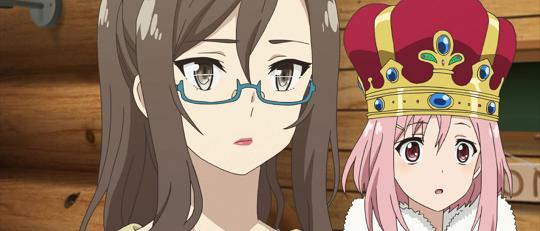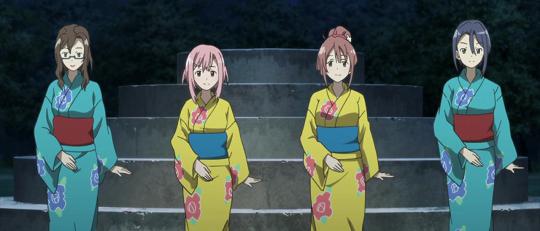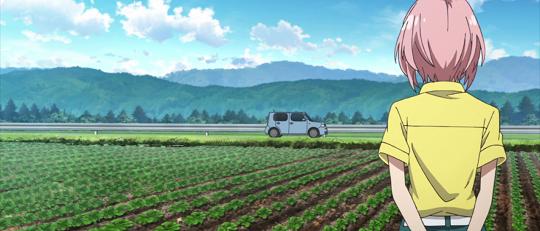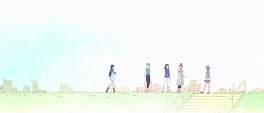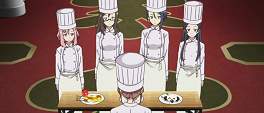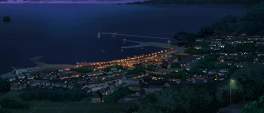Sakura Quest is the most recent series from studio P.A. Works’ “earnest girls working earnestly” genre that it started back in 2011 with Hanasaku Iroha. Sakura’s story starts charmingly enough with the cherry-blossom haired Yoshino being mistaken for a singer from the 60’s and subsequently being hired by the tourist board as a representative of the rural town, Manoyama. Thus begins twenty five episodes of Yoshino and fellow cohorts Shiori, Maki, Ririko and Sanae trying to revitalise the ailing town.
At its heart, the series is about people fighting against the depopulation of a rural town. Once it moves past its initial two-episode stories of Yoshino attempting (and failing) with quick-fire tourist pulls, there are extended arcs focusing on the aging residents on the outskirts of town, as well as the perils of using flashy media pulls, alongside an undercurrent of resigned acceptance to the situation the town finds itself in. And what ultimately awaits it should the situation continue.
Rural depopulation isn’t a situation that is unique to Japan, much of the developed world is suffering from it with many towns across Europe facing a similar fate. The causes are well understood: the young leave the countryside for the cities to seek better employment opportunities and economic stability leaving an increasingly older population to tend the fields. Strange then that from the outset, Yoshino has the opposite happen to her, struggling as she is to find a job in Tokyo, the call to the countryside is a welcome chance for her.
Though never stated in the show, it’s commonly understood that Manoyama is based upon the town of Nanto which geographically is several hours journey outside of Tokyo. This excludes Manoyama from the effect of counter urbanisation where the movement of people to rural areas with easy access to cities has been a recent phenomenon - probably trying to escape Tokyo living costs.
Yoshino is set the nebulous task of improving Manoyama’s tourism within the year of her contract. She stands on the ruins of past attempts though, the most obvious of which is the Chupakabura town hall that is sporadically used as a base for Yoshino’s efforts. Again, though never stated in the show, it’s likely this hall was built as a result of real life fund injection in the 1980’s by then prime minister Noboru Takeshita. Effectively dumping millions of yen into rural communities to use as they wished, the results were varied only in their ineffectiveness. One town, Tsuna, however purchased a weighty gold nugget with its money, attracting tens of thousands of tourists in the process but ultimately being absorbed along with other surrounding towns into Awaji in 2005, the same fate that Manoyama faces at the end of the series.
There is talk within Sakura Quest of the “kingdom” style rejuvenation projects that happened across Japan in the past, whether this was a real project or not I’ve been unable to verify, but the building of the garish hall is a luridly coloured example of the kind of policies and politics that rural Japanese communities are operating under.
Specifically, the fight against the gravitational pull that is the Tokyo Metropolitan area. More so than many other countries, the seats of power both political and economic lie within Tokyo; yet to remain in power, votes from other areas of the country are needed. So instead of offering tangible but boring long term improvements, far easier is it to dazzle with shock and awe with projects like stadiums, multi-lane highways and “multi-purpose halls” common touchstones for politicians looking to curry rural votes. This might also go some way to explaining the incongruous climbing wall and “observation tower” that Manoyama sports. Beneath this bureaucratic impropriety there is the more complex issue of funding and the industrial construction complex that the majority of Japanese companies are at the mercy of which feeds into the idea of economic power, but not important in terms of Sakura Quest and Manoyama. Suffice it to say, this could explain the egregious rural boondoggles.
With that kind of hostility to long term rejuvenation, it’s no wonder that Manoyama’s small businesses are reticent to change. The revelation part way through the series that many of the shuttered shops are closed but not vacant begins to pick at the cultural mentality underpinning the town’s situation: the young want the town to do well but those able to do something don’t want to change.
There’s a sense of stoic nobility that the shopping district has accepted its fate with dignity, a sentiment borne out by the older community visited by Yoshino and co later in the series. It’s also the point where the narrative takes a turn for the peculiar and dramatic. At the heart of this change in tone is the charismatic Professor, a cultural anthropologist whose presence in the village only seems to underscore its slide towards decline, but does highlight the kind of community thinking at play with the delightfully morbid “we’re alive” lanterns that are later co-opted for the Manoyama festival.
The question then that the series tries to answer (and it’s not alone in trying) is how best to stop the decline and eventual death of a town? For many towns and villages around the world a reprieve has come from immigration. For Manoyama, this seems like an unlikely prospect despite the charming self-insert Sandal-san and the bevvy of foreign tourists that visit throughout the series. It’s no secret that Japan has always taken the mentality of an “island nation” to heart, being notoriously unwelcoming to immigrants yet blithely inviting tourism.
Increasing the birth rate then? While the irony of targeting a typically herbivorous male past-time and medium towards this solution, Japan leads the world with its greying population and plummeting birth rate, so even the quirky dating tourism (husband shopping) shown in the series is unlikely to solve the problem. Other rural villages have historically taken to wooing foreign women in an attempt to ameliorate their decline.
To its definite credit, Sakura Quest doesn’t attempt to offer a single solution, instead ending the series with a dramatically ho-hum summation of efforts. This includes the repurposing of buildings, including the school for a new business centre and empty houses for short-stay residences. The latter a definite improvement over the usual demolition and rebuilding of structures - see also the climax of the “zombie film” Manoyama plays host to - that is so common due to inheritance laws and associated costs. Likewise the celebration of local culture certainly didn’t have the big-bang effect that was maybe expected for a series’ climax, but underscores a more subtle understanding and appreciation of place that is felt more than seen.
Most pleasingly though was the acceptance of new technologies. With terminal murmurer Ririko leading the charge with live webcasts of events, along with the elderly connecting and passing on knowledge with tablets and computers. Even Sanae was a breath of fresh air with her entrepreneurial spirit - especially rare in Japan that lacks the “startup” culture of America - and her meetings with other business minded women hinting at the possibility of remote teleworking, or just simply the ability for certain jobs to work from anywhere.
With that message of hope though is the eventual understanding that all of their efforts likely only prolonged the inevitable: Manoyama is still going to be absorbed and renamed and Yoshino herself dashed off to much warmer climes. Going from dunderheaded quick fixes to understanding and gradual change mirrors Yoshino’s journey from bratty Tokyoite to community do-gooder. The initial “problem-solution?-failure” structure of earlier stories threatens to undermine the later ones’ much stronger, more affecting arcs; indeed, failures like the “school lunch cook in” in the latter half are accepted and learned from rather than dwelt upon.
The conjoining of narrative to message though doesn’t make up for the series’ frequent inconsistency or inability to maintain interest outside of some light-touch iyashikei elements. But in tackling a complex and hugely important social issue with an appreciable amount of depth, it came off better than most. The representation of all the different types of people that contribute to the situation - the elderly, the entrenched, the skeptical, the curmudgeonly, the positive and the resigned - is to be commended, but there is a lingering question as to who Sakura Quest is for.
If the answer to that is foreign viewers with more interest in Japanese socioeconomic issues than their own country’s, then perhaps like Manoyama itself, the series is soon to be forgotten.
